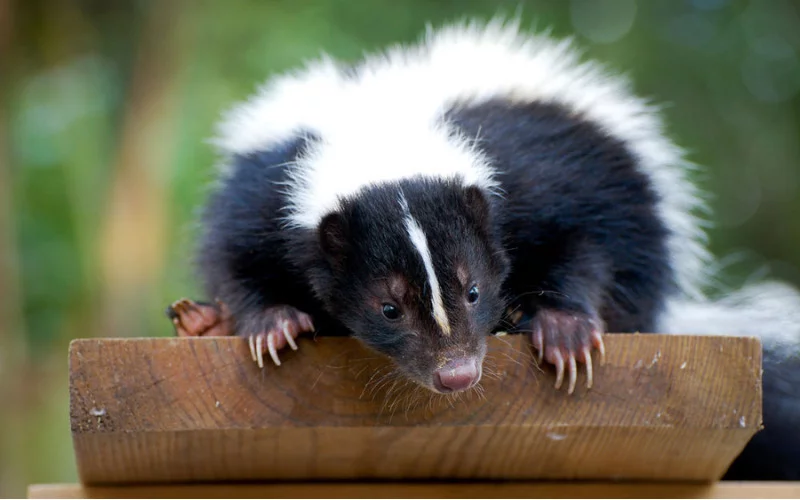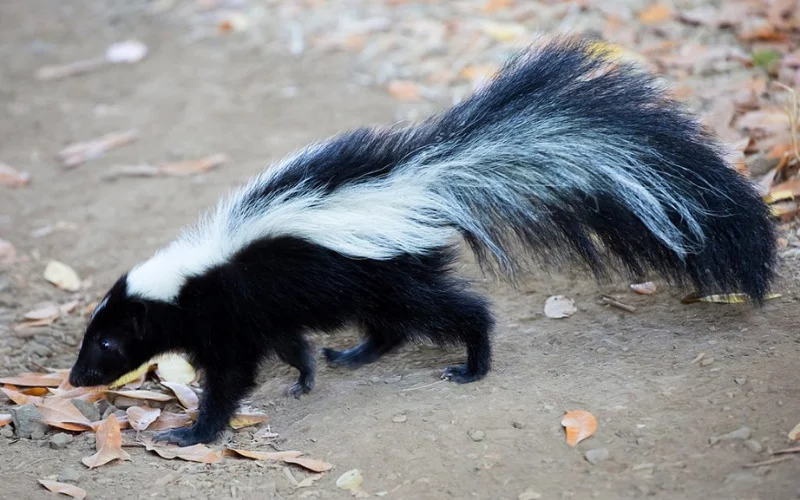Skunks are tiny rodents, but they are also one of the most feared animals because of their spray, which is probably the most irritating of all smells.
Another reason why many people don’t like a skunk is because they can destroy a lot of things as they burrow in places making holes and getting into places they are not wanted, thus constituting a nuisance.
Perhaps skunks can fit into small holes that look a lot smaller than their bodies, which helps them survive and generally get into places where they cause a lot of damage.
It will amaze you to know that a full-grown skunk can fit into a hole that is just 4 inches in diameter, it sounds almost incredible, but it is true.
Let’s Get To Know Skunks
There are many species of skunks found in many parts of the globe, but the striped skunks are about the most common of them. They have their characteristic pointed snout and very long and pillow-like tails.
They have small legs that are stumpy, and they weigh about 3kg when they are fully matured and can get as long as 80cm.
They have very thick fur that makes them look bigger and heavier than they are, their fluffy fur stands somewhat upright, and because they are soft, they serve as a lubricant that helps them squeeze themselves through very small holes easily.
Skunks have very long nails and strong forefeet, and it is with these, that they can dig through very difficult places in search of food and shelter, which makes them excellent diggers.
How Big Of A Hole Can A Skunk Get Through?
Skunks are voracious eaters who eat a lot of different kinds of things, from insects and bugs to fruits, nuts, and vegetables, and they can try to gain access to any place in the home as they search for food or shelter.
So, the decks, under porches, and other places are not spared as these rummaging, and burrowing menace get into a house.
This quest for food or when they are running away from predators (they have quite a few of many) that see them going through very small openings or holes.
These rodents can easily fit through holes that look a lot smaller than their body sizes. A fully grown skunk can fit into a hole 4cm in diameter; this is possible because of their fur. This fluffy fur serves as a lubricant that allows the skunk to fit through tiny holes.
So, the same way you oil a nut and bolt to allow the nut to slip out, that is exactly what the fur does in allowing the skunk to go through a small hole.
The Kind Of Holes Skunk Dig
Like raccoons and possums, skunks are burrowing animals that leave a lot of holes wherever they go, but it is a little hard to tell which of these animals dug the holes you see, and hence what animal you might have to watch out for in your space.
You might require the help of a professional to check out your property so that they can tell you if you have skunks or other animals on your property.
There are, however, some signs that differentiate the holes dug by skunks from those dug by raccoons or opossums.
Skunks dig two kinds of holes: The first kind of holes dug by skunks are usually shallow ( about 3inches deep ) and small (about 3 to 5 inches in diameter).
These holes are shallow and small because they are the holes they make as they search for food like earthworms, grubs, and bugs.
They dig the second kind of hole in the holes they nestle and sleep in. These burrows are about 8 inches wide and quite deep, so you cannot see the nest.
Another tell-tale sign that reveals if a skunk, raccoon, or possum dug or lives in a given hole is the type of hair you find around the hole. You can do this by checking the hole’s edge to see the kind of hair around it.
Skunks usually leave a few hairs behind in the entrance of their nests. This is not the case with possums, especially the raccoons who leave behind small clumps of fur trying to squeeze into the hole.
Where Do Skunks Usually Dig Around The House?
Skunks dig holes anywhere they feel safe; it can be in the garden, in a fallen log of wood, on a large rock, or in any part of the yard that does not get disturbed easily. They will dig holes under any object they believe to be sound and can protect it from predators and Invaders.
Outdoor structures like the sheds, deck, and patio are some places around the home that Skunks dig, and in so doing, they affect the structural integrity of the house’s foundation.
How To Prevent Skunk Damage

Skunks do not dig holes for the fun of it, especially if they are the larger holes where they nestle, and they will continue to return to the holes if they believe that there is no threat.
Hence the moment you see or suspect the presence of skunks in your house, you should ensure that you take immediate action that sends the message that they are unwanted visitors; failure to do this is just giving them positive reinforcement to continue living in your space.
Another factor that keeps skunks coming to your home is probably they have a constant supply of appealing food around.
If your trash can is filled with foods they can eat, or there are lots of insects or bugs around your house, you should expect skunks always to come around and even make a nest in your home.
Even though you might not be able to eliminate all the food sources of skunks around your home, you can try to make getting food difficult for them by treating your gardens and lawns for grubs.
How To Keep Skunks At Bay
There are a few reasons you will want to keep Skunks far from your property. Firstly, they are wild animals and will always tend to make them what they are.
Secondly, they cause a lot of havoc and destruction around the home that can be disastrous.
Another reason that people do not always remember is that these animals can carry pathogens on themselves. When they come close to us, we can easily contract the diseases these pathogens carry.
Here are some things you can do to prevent skunks from gaining access to your space by either climbing the fence or simply digging their way underground.
1. Build a fence around your property at least 6 feet high so that skunks cannot climb their way through it. You can add motion-activated floodlights, which will dazzle the skunks when they get to the fence. Remember, skunks are nocturnal animals and do not love bright lights
2. Get a motion-activated sprinkler that will spray water on skunks or other animals that strays into your house
3. You should put smooth metal high enough along the bottom of the fence so that they don’t climb the fence.
4. Ensure there are no trees near your fence from which skunks can climb to get to your house.
5. Electric fence is a good way of keeping skunks far away from your property.
6. A few skunk repellent sprays are sold online and in stores that you can spray along your fence to keep skunks away.
7. Build fences with smooth materials like concrete sleepers so that skunks can’t climb through them or use treated hardwood for building wooden fences to prevent skunks from biting through the fence.
8. You should ensure that your fence extends not less than 3 feet underground to ensure that skunks don’t dig underground the fence to get into your house.
9. You can take a drastic approach to keep skunks off your yard by digging a one-by-one foot trench along the perimeter of your fence.
Afterward, you should secure poultry netting or wire mesh in the bottom of the hole and along the trench and then fill it with dirt. This is to ensure that there is no way skunks can gain access into your yard, no matter how hard they try.
Conclusion
Like many other rodents, skunks can fit into very small holes that are a lot smaller than their size, all thanks to their flurry fur, which acts like a lubricant that makes maneuvering through such small holes a piece of cake.
Skunks are little wild animals that can cause a lot of havoc if left unchecked in our space; they cause a lot of destruction and damage to buildings, carry diseases, and spray one of the most smelly sprays that there are. So, you should take precautions to ensure you don’t court this burrowing rodent in your home.
You May Also Like:
- How Far Can Raccoons Jump
- Can Raccoons Eat Chocolate
- Do Skunks Climb Trees or Fences?
- Can I Shoot a Possum in My Backyard
- Can You Eat Squirrel From Your Backyard
We trust this article helped you determine how small a hole can a skunk fit through. You may also want to check out How High Can a Raccoon Jump.
Thanks for taking the time to read our article, and we hope you find it helpful. Would you mind leaving a comment below if you have any suggestions?
Kindly reach out to people by sharing this post on social media.
If you liked this article, then please follow us on Facebook, Instagram, and Pinterest.

